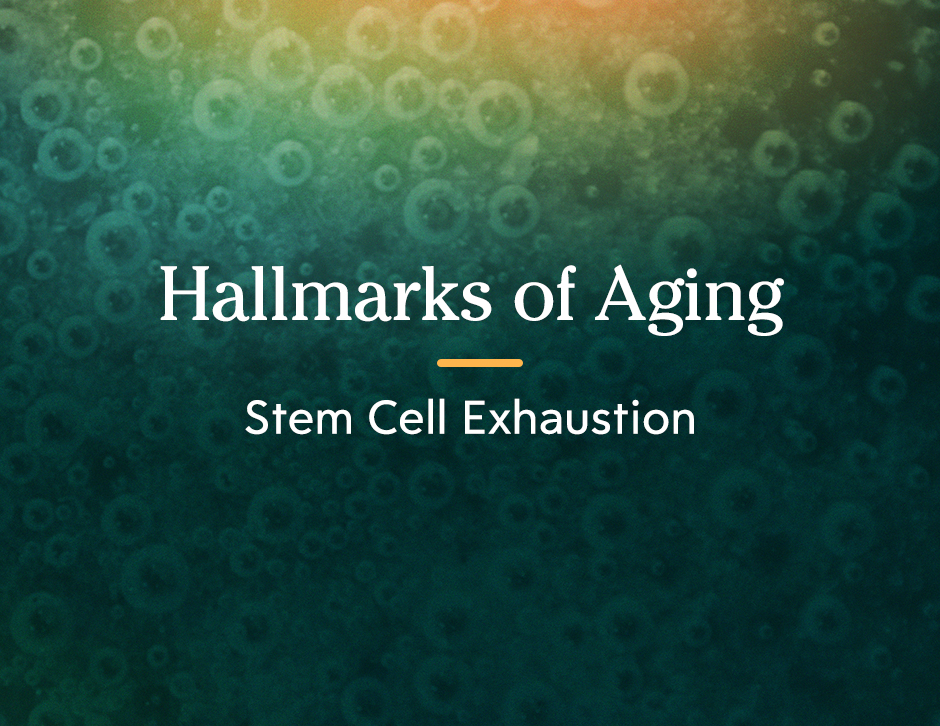
A quick overview of what you’ll learn from this blog post:
- What is stem cell exhaustion?
- How it happens
- The consequences of stem cell exhaustion
The Hallmarks of Aging describes stem cell exhaustion as the failure of stem cells and their ability to produce a supply of fresh somatic cells to organs and tissues.
As a hallmark of aging, stem cell exhaustion is one of the root causes of aging. As our stem cells deplete, we can experience any number of age-related conditinos as a result, such as frailty and the decline of the immune system, and organ failure.
But what is stem cell exhaustion, and how does it cause aging? Let’s explore.
The master cells that keep our organs and tissues alive
Ok, first thing’s first: let’s explain what a stem cell is exactly.
These are master cells from which all other cells in our body are created. These master cells are much more flexible do compared to the more specialized somatic cells, which make up the bulk of our total cells. This is because stem cells have a greater level of control over their gene expression pattern.
Given the correct conditions, stem cells will divide to make daughter cells. With appropriate chemical cues, these daughter cells can become any type of cell in the body. Stem cells make up a small percentage of our total cells, but keep our organs and tissues going with a supply of fresh healthy cells to replace those that die.
Stem cells also improve tissue function, regeneration, and health through beneficial signaling. This signaling is so useful for promoting tissue repair that some researchers are developing the chemicals they secrete as a form of therapy.
For these same reasons, any loss of stem cell activity can have harmful consequences. When stem cell exhaustion occurs as a result, the body undergoes immunosuppression and frailty dur to muscle loss, weakening bones, and a decline of white blood cells production.
How does stem exhaustion happen?
As we get older, the activity of our stem cells gradually slows down. This happens due to a number of factors:
- Senescent cell accumulation occurs as we age and is thought to be a reason we age. These problem cells secrete a cocktail of pro-inflammatory signals known as senescence-associated secretory phenotype (SASP). The SASP is immunosuppressive and inflammatory and reduces the activity of stem cells and its ability to regenerate tissue.
- Inflammaging is a term used to describe systemic inflammation which typically rises with advancing age. It is fueled from a number of sources including, adverse changes to our gut bacteria (microbiome), cell debris, senescent cell accumulation and immunosenescence.
- Loss of stem cell populations
Just like somatic cells, stem cells can also become damaged and destroyed. Telomere attrition can cause stem cells to cease working and become senescent, and in turn cancer or cellular senescence. - B12 stem cell exhaustion
Stem cells need vitamin B12 to function properly. B12 is also crucial for cell division and DNA synthesis, which helps stem cells regenerate. Without enough B12, our body undergoes B12 deficiency, which can cause stem cell exhaustion. When this happens, the stem cells in bone marrow can’t reliably produce red blood cells, leading to anemia as well.
What can we do about stem cell exhaustion?
It might all seem a bit complicated at first glance, but researchers have some ideas about how to combat this problem. There are even a few things you can do yourself too.
- Clearing senescent cells using senolytic drugs to reduce SASP
- Boosting NAD+ and metabolism to boost stem cell activity
- Reducing inflammaging through good diet, lifestyle and exercise
- Targeting the sources of inflammaging with drugs and therapies
- Replacing lost stem cells with new patient-matched stem cells
- Supplementing B12 to avoid a deficiency
The good news is that stem cell research is one of the most well-funded areas of aging research and advances are coming at a steady pace. It is not unreasonable to believe that in the near-future, researchers will be able to create any types of stem cells in the body and use them to replace age-related losses.
As we wait for further research, we can rely on methods like NAD+ and B12 to delay or prevent stem cell exhaustion, so we can live longer, healthier lives.
Note: The above statements have not been evaluated by the Food and Drug Administration. This product is not intended to diagnose, treat, cure, or prevent any disease.
